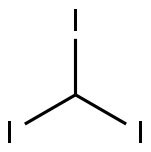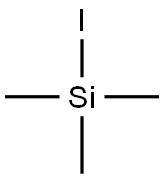Iodoform , AR,99% , 75-47-8
Synonym(s):
CHI3;CHIT;chitinase 1 (chitotriosidase);Triiodomethane
CAS NO.:75-47-8
Empirical Formula: CHI3
Molecular Weight: 393.73
MDL number: MFCD00001069
EINECS: 200-874-5
PRODUCT Properties
| Melting point: | 119 °C |
| Boiling point: | 218°C |
| Density | 4.008 g/mL at 25 °C(lit.) |
| refractive index | 1.4975 (estimate) |
| storage temp. | -20°C |
| solubility | chloroform: soluble5% |
| form | Crystalline Powder |
| color | Bright yellow to dark yellow |
| Odor | char. pungent odor |
| biological source | mouse |
| Water Solubility | Insoluble. <0.1 g/100 mL at 24 ºC |
| Sensitive | Light Sensitive |
| Merck | 14,5033 |
| BRN | 1697010 |
| Exposure limits | ACGIH: TWA 0.6 ppm NIOSH: TWA 0.6 ppm(10 mg/m3) |
| Stability: | Stable. Incompatible with strong oxidizing agents, reducing agents. May explode when heated. |
| LogP | 3.510 (est) |
| CAS DataBase Reference | 75-47-8(CAS DataBase Reference) |
| NIST Chemistry Reference | Methane, triiodo-(75-47-8) |
| EPA Substance Registry System | Iodoform (75-47-8) |
Description and Uses
Iodoform is a stable, pale yellow crystalline solid. It is volatile with a characteristic pungent, unpleasant and penetrating odour, but with a sweetish taste. It is incompatible with strong oxidising agents, reducing agents, lithium, and metallic salts such as mercuric oxide, silver nitrate, strong bases, calomel, and tannin. Reports indicate that earlier iodoform was in use as a disinfectant and as an antiseptic or dressing and healing of wounds and sores for pets. Iodoform is the active ingredient in many antiseptic or dressing powders used for dogs and cats to prevent infection.
Iodoform has limited use as a chemical intermediate and for medicinal purposes as disinfectant and antiseptic and has been used in veterinary medicine.
Safety
| Symbol(GHS) |   GHS06,GHS09 |
| Signal word | Danger |
| Hazard statements | H302+H312-H315-H319-H331-H335-H411 |
| Precautionary statements | P273-P280-P301+P312-P302+P352+P312-P304+P340+P311-P305+P351+P338 |
| Hazard Codes | Xn |
| Risk Statements | 20/21/22-36/37/38 |
| Safety Statements | 26-36/37-36/37/39-22-24/25 |
| RIDADR | UN 1851 |
| OEB | B |
| OEL | TWA: 0.6 ppm (10 mg/m3) |
| WGK Germany | 3 |
| RTECS | PB7000000 |
| F | 13 |
| TSCA | Yes |
| HS Code | 29033990 |
| Hazardous Substances Data | 75-47-8(Hazardous Substances Data) |
| Toxicity | LD50 s.c. in mice: 1.6 mmoles/kg (Kutob, Plaa) |





